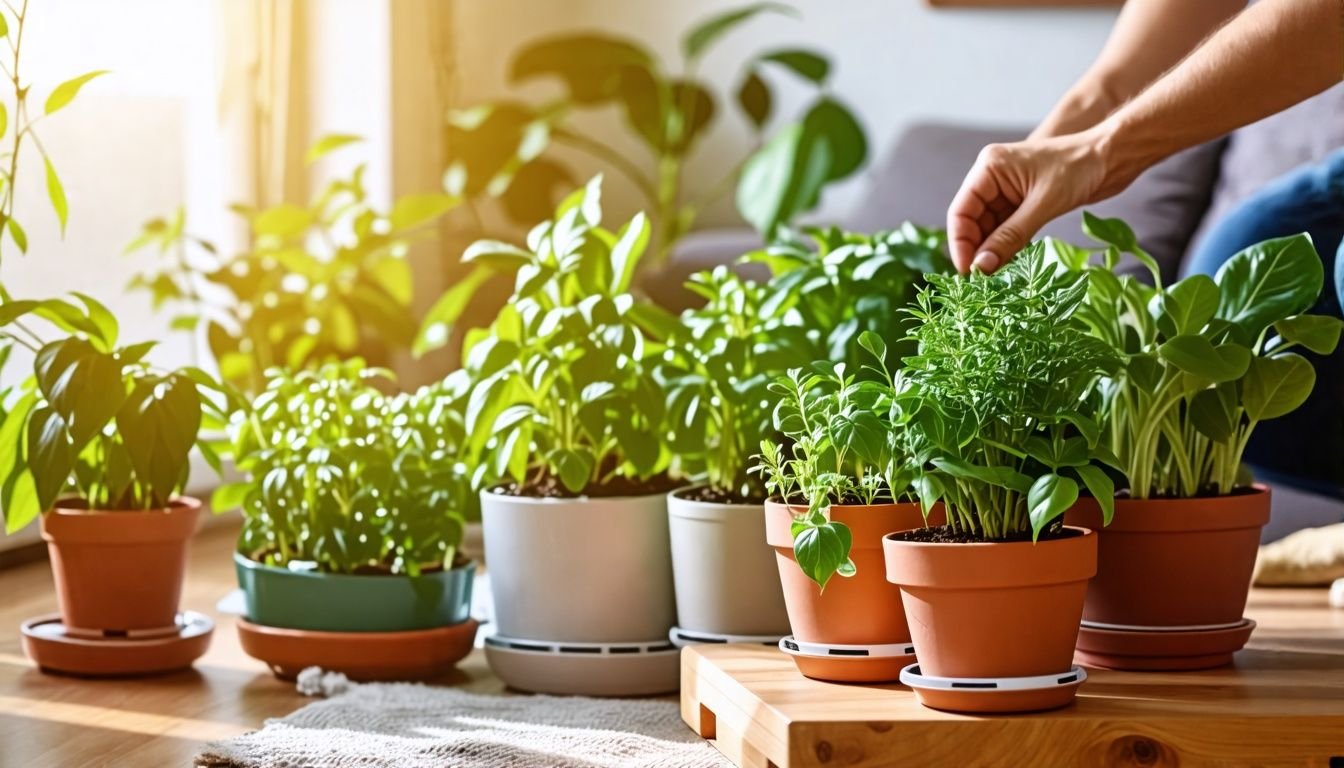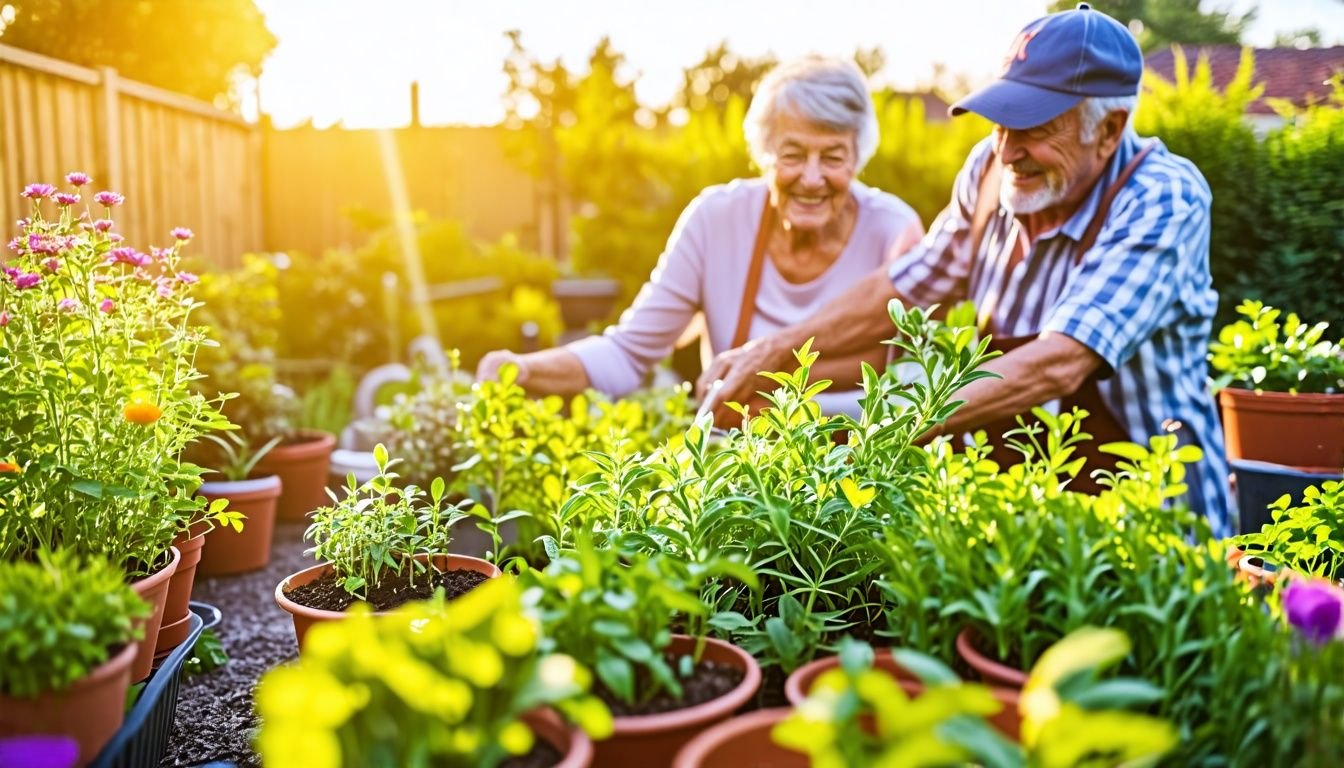G’day, fellow plant lovers! Are you sick of coming home to sad, droopy plants? We get it – it’s a real pain when you forget to water your green mates. It’s a common drama for busy gardeners.
But no worries, there’s a fantastic solution that can make your life a whole lot easier: self-watering pots.
We’ve watched our own beloved herbs wilt from lack of water too many times. That’s why we’ve thoroughly researched self-watering planters. These clever pots can cut down water usage by up to 30% compared to the old-school methods.
We’ve done the hard yakka to bring you the best tips and tricks for using these handy gardening tools.
In this guide, we’ll show you how self-watering pots work their magic, their benefits, and how to pick the right one for your needs. Whether you’re growing veggies or tending to a herb garden, we’ve got you sorted.
Ready to make plant care a piece of cake?
Key Takeaways
- Self-watering pots can cut water usage by up to 30% compared to traditional methods, making them ideal for Australia’s hot, dry climate.
- These pots feature clever reservoir systems and wicking mechanisms that provide consistent moisture to plants, reducing watering frequency to as little as once a week.
- When choosing a self-watering pot, consider size (14cm to 80cm options), material (plastic, ceramic, or terracotta), and price range ($32 to $1,249) to suit your needs and budget.
- Vertical Gardens Direct offers a range of self-watering pots, including popular brands like Glowpear and Lechuza, with prices starting from $116 for the Lechuza Balconera 80 Self Watering Pot.
- Proper use of self-watering pots involves selecting the right potting mix, regular reservoir checks, cleaning to prevent algae growth, and adjusting watering habits for different seasons.
Key Features of Self Watering Pots

Self-watering pots have smart features that make plant care easier. These pots use clever systems to keep your plants happy and healthy with less work from you.
Reservoir Systems
We love the clever design of reservoir systems in self-watering pots. These systems feature a hidden water tank at the bottom of the pot. This tank holds extra water for your plants.
The reservoir keeps moisture levels steady, which is great for plant health.
Our plants drink from the reservoir through a special wicking system. This system moves water from the tank to the soil as needed. We find this setup brilliant for busy gardeners or those who travel often.
The reservoir can hold enough water to last several days or even weeks, depending on the pot size and plant type.
We’ve seen reservoir sizes vary widely in self-watering pots. Some hold just enough for a few days, while others can last weeks. Prices for these pots start at $20 and can go over $100 for larger, fancier models.
The cost often reflects the size and quality of the reservoir system.
Wicking Mechanisms
Moving from reservoir systems, we now explore the heart of self-watering pots: wicking mechanisms. These clever devices form the bridge between the water storage and your plants’ roots.
Wicking works through capillary action, drawing moisture upwards like a sponge. This process ensures a steady supply of water to your urban garden or vegetable patch.
Our Australian mates often ask us about the best wicking materials. We’ve found that synthetic fibres or porous materials work well. These include nylon ropes, felt, or even special potting mixes designed for wicking.
The key lies in their ability to pull water against gravity, keeping the soil moist but not waterlogged. This balance promotes healthier root growth and stops overwatering, a common issue in traditional pots.
Wicking mechanisms shine in our harsh Aussie climate. They help plants thrive during hot, dry spells by providing constant hydration. For busy gardeners or those with irregular schedules, these systems offer peace of mind.
Your plants can access water as needed, reducing the risk of wilting or stress. This feature makes self-watering pots ideal for water-loving plants like peace lilies, pothos, and spider plants.
Benefits of Using Self Watering Pots
Self watering pots offer a game-changing solution for plant care. These clever containers provide a steady water supply, keeping your plants happy and healthy with less effort from you.
Consistent Moisture Supply
We love how self-watering pots keep our plants happy with steady moisture. These clever pots have a reservoir that feeds water to the soil as needed. This means our green friends get just the right amount of water, not too much or too little.
It’s like having a personal plant nanny!
Our plants thrive with this constant care. They face less stress and grow healthier roots. This system works wonders in Australia’s hot, dry climate. We can relax knowing our plants won’t dry out on scorching days.
Plus, we don’t need to water as often, which is great for busy urban gardeners or veggie growers.
Reduced Watering Frequency
Moving from consistent moisture supply, self-watering pots also offer a major perk: less frequent watering. This feature proves invaluable for urban gardeners and veggie growers alike.
Our busy lives often leave little time for daily plant care. Self-watering pots step in to fill this gap, keeping our green friends happy with minimal fuss.
These clever containers cut down watering chores significantly. Instead of daily checks, we might only need to top up the reservoir once a week or even less. This reduction in watering frequency is a game-changer for plant lovers who travel often.
We can jet off for short trips without worrying about our plants drying out. The pots’ built-in water level indicators also take the guesswork out of refilling. A quick glance tells us if our plants need more water, saving time and effort.
For Aussie gardeners, this means more time enjoying our outdoor spaces and less time lugging watering cans. Whether we’re growing veggies on a balcony or tending to indoor plants, self-watering pots offer a smart solution.
They automate a key part of plant care, freeing us up to focus on other aspects of gardening or simply relax in our green oasis.
Choosing the Right Self Watering Pot
Picking the perfect self-watering pot can make or break your gardening success. We’ll guide you through the key factors to consider, from size to material, to help you make the best choice for your plants.
Considerations for Size and Material
We know choosing the right self-watering pot can make or break your gardening success. Let’s explore the key factors to consider when selecting the perfect size and material for your urban garden or veggie patch.
- Size matters:
- Match pot size to plant needs (14cm to 80cm options available)
- Larger pots suit bigger plants or those with extensive root systems
- Smaller containers work well for herbs and compact vegetables
- Material options:
- Plastic: Lightweight, affordable, and comes in various colours
- Ceramic: Stylish, but heavier and more fragile
- Terracotta: Porous, allows air flow, but may dry out faster
- Weight considerations:
- Plastic pots are ideal for balconies or areas with weight limits
- Heavier materials like ceramic provide stability for taller plants
- Drainage features:
- Check for proper drainage holes to prevent waterlogging
- Some materials, like terracotta, offer natural moisture regulation
- Aesthetic appeal:
- Choose a pot that complements your outdoor or indoor space
- Consider how the material will age over time
- Budget-friendly options:
- Prices range from $32 to $1,249, catering to various budgets
- Plastic pots often offer the most affordable choices
- Durability and longevity:
- Ceramic and terracotta pots can last for years with proper care
- Plastic pots may need replacement more frequently
- Climate considerations:
- In hot Australian climates, choose materials that retain moisture well
- For cooler areas, opt for pots that warm up quickly in the sun
Tips for Optimal Use
Self-watering pots can make urban gardening a breeze. Here are some top tips to get the most out of your pots:
- Choose the right potting mix. Use a high-quality blend that suits your plant species. This helps roots grow strong and healthy.
- Water from above at first. Give your plants a good soak when you first pot them. This helps roots settle and reach the wicking system.
- Check the reservoir often. Top up the water when it’s low, especially on hot days. This keeps your plants happy and hydrated.
- Clean your pot regularly. Wipe it down to stop algae from growing. A clean pot means healthier plants.
- Don’t overfill the reservoir. Leave some air space to prevent root rot. Your plants will thank you for it.
- Pick the right spot. Place your pot where it gets the right amount of sun for your plant type. This helps your green friends thrive.
- Adjust for seasons. Fill the reservoir more in summer and less in winter. Your plants need different care as the weather changes.
- Feed your plants right. Add liquid fertiliser to the reservoir now and then. This gives your plants the nutrients they need to grow strong.
Visit Our Partner for Your Self Watering Pot Needs
We’ve partnered with Vertical Gardens Direct to bring you top-notch self-watering pots. They offer a wide range of options to suit your needs. From indoor planters to wall and hanging pots, you’ll find the perfect fit for your space.
Their catalogue includes popular brands like Glowpear and Lechuza, known for quality and style.
The right pot can make all the difference in your gardening success.
Prices at Vertical Gardens Direct start from $116 for the Lechuza Balconera 80 Self Watering Pot. For those wanting larger options, the Glowpear Urban Garden Self Watering Planter Box is available for $228.
You can sort products by price, popularity, or alphabetically to find exactly what you need. With their variety of sizes, shapes, and colours, you’re sure to find the perfect self-watering pot for your Aussie garden.
Conclusion
Self-watering pots offer a smart solution for plant lovers. They provide steady moisture and cut down on watering chores. These pots suit busy gardeners and those new to plant care alike.
With the right pot, you’ll enjoy healthier plants and more free time. Explore our range of self-watering pots to find your perfect match and watch your garden thrive.
FAQs
1. How do self-watering pots work?
Self-watering pots use a reservoir system to provide plants with water as needed. The pot has two chambers: one for soil and plants, and another for water storage. A wick or capillary action draws water up to the plant roots, ensuring consistent moisture levels.
2. What are the benefits of using self-watering planters?
These planters offer several advantages. They reduce watering frequency, promote healthier plant growth, and prevent over-watering. Self-watering pots also help conserve water and are ideal for busy gardeners or those who travel often.
3. Can all plants thrive in self-watering containers?
Most plants adapt well to self-watering systems. However, some drought-tolerant species or those prone to root rot may not suit these pots. It’s crucial to research your specific plant’s needs before using a self-watering container.
4. How often should I refill the water reservoir in my self-watering pot?
The refill frequency depends on factors like plant type, pot size, and climate. Generally, check the water level weekly. Top up when the reservoir is about one-third full. This practice ensures your plants always have access to water without risking stagnation.
